The journey of the cranberry from the bog to the annual holiday dinner table does not follow a straightforward path.
Although the link between American fall and winter holidays, roasted turkey, and cooked cranberries is a tight one in the current food landscape, there is no clear precedent for these particular foods within the history of Thanksgiving. This short review shares the small amount of evidence to support the tradition of cranberries with Thanksgiving and early American cuisine, along with the ways in which the U.S. Department of Agriculture supported farmers as they established, grew, and maintained this unique food crop. The USDA's Agricultural Research Service is also investigating this food for its unique properties, including its ability to prevent urinary tract infections and its nature as a source of flavonols.

The most prominent early mention of the nature and value of the cranberry in American cuisine was made by John Josselyn in his 1672 work New England's Rarities Discovered in Birds, Beasts, Fishes, Serpents, and Plants of That Country. The National Agricultural Library has digitized its copy of this work and made it available here.
James W. Baker provides a good transcription of Josselyn's description of the cranberry's value in his history, Thanksgiving: The Biography of an American Holiday. Lebanon, NH: University of New Hampshire Press (2009):
Cran Berry, or Bear Berry, because Bears use much to feed upon them, is a small trayling [trailing] plant that grows in the Salt Marshes that are over-grown with Moss; the tender Branches (which are reddish) run out in great length, lying flat on the ground, where at distances, they take Root, over-spreading sometimes half a score [about twenty] Acres, sometimes in small patches of about a Rood [approximately a quarter of an acre] or the like; the Leaves are like Box [Buxus] but greener, thick and glistering; the Blossoms are very like the Flowers of our English Night Shade, after which succeed the Berries, hanging by long small foot stalks, no bigger than a hair; at first they are of a plane [plain] yellow Colour. Afterwards red and as big as a Cherry; some are perfectly round, others Oval, all of them hollow, of a sower [sour] astringent taste; they are ripe in August and September.
For the Scurvy.
They are excellent against the Scurvy.
For the heat in Fevers.
They are also good to allay the fervour of hot Diseases.
The Indians and English use them much, boyling [boiling] them with sugar for Sauce to eat with their Meat; and it is a delicate Sauce, especially for roasted Mutton; Some make tarts with them as with Goose Berries.
-- p. 51-52
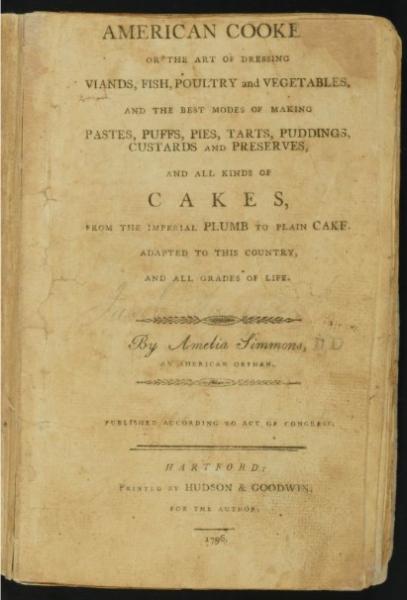
Over a hundred years later in 1796 Amelia Simmons recommended in the landmark volume American Cookery that turkey be served with "boiled onions and cranberry-fauce [sauce], mangoes, pickles, or celery" p. 19.
Finally, Andrew F. Smith observed the following in the Oxford Companion to American Food and Drink (2007). New York: Oxford University Press:
During the Nineteenth century, cranberries were used extensively in pies, sauces, jellies, jams, preserves, puddings, dumplings, marmalades, and ketchup. Cranberries were also mashed and made into a beverage called 'cranberryade.'
-- p. 174

By 1942 cranberry sauce had become a standard item at the holiday dinner table. This recipe appeared in the issue of Homemaker News titled "Cranberries Add Zest to Meals" created by the home economists at the USDA Bureau of Home Economics. (The corn syrup and honey alternatives were suggested because of the then current rationing of sugar due to World War II.)
1 quart (1 pound) of cranberries
1 1/2 cups of water
2 cups sugar (or 1 cup sugar and 1 cup corn syrup or mild honey)
Pick over the cranberries and discard all that are withered or specked. Bring the sugar and the water to the boil, add the berries, and cook quickly for about 10 minutes, or until the skins break. Chill the sauce before serving.
In the early years of the twentieth century the U.S. Department of Agriculture was sending artists out to the field to visually document different varieties of fruits. Seven varieties of American cranberry (Vaccinium macrocarpon) were documented and are available for public view.
These images are part of The National Agricultural Library's USDA Pomological Watercolor Collection. In 1886, the United States Department of Agriculture (USDA) established the Division of Pomology to oversee the collection and distribution of new varieties of fruits, and to disseminate information to fruit growers and breeders. USDA commissioned artists to create technically accurate illustrations of newly introduced cultivars for the division's publications. The USDA Pomological Watercolor Collection contains reproductions of 7,497 watercolor paintings, including the seven samples of American cranberry.
(Images courtesy of the U.S. Department of Agriculture Pomological Watercolor Collection. Rare and Special Collections, National Agricultural Library, Beltsville, MD 20705)
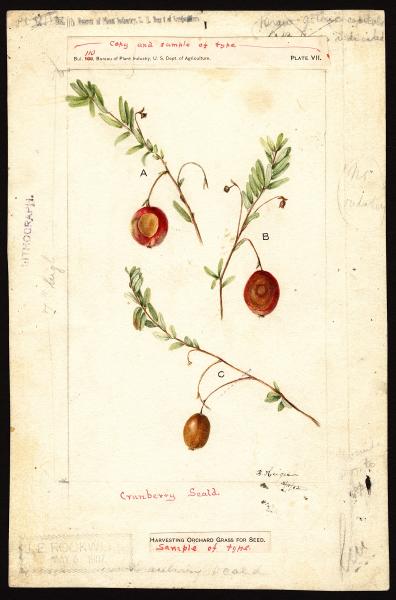
Vaccinium macrocarpon
Artist: Heiges, Bertha
Date: 1902
Scientific name: Vaccinium macrocarpon
Common name: American cranberry
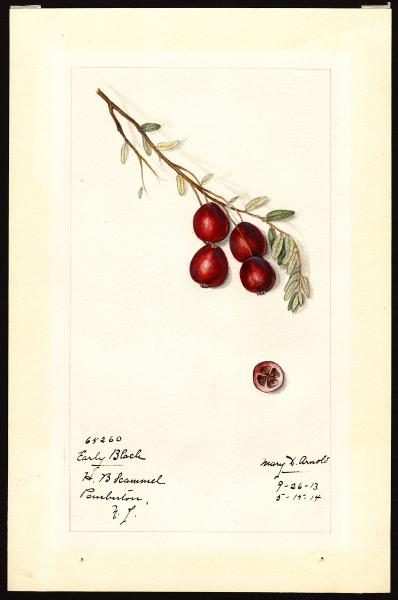
Vaccinium macrocarpon: Early Black
Artist: Arnold, Mary Daisy
Date: 1914
Scientific name: Vaccinium macrocarpon
Common name: American cranberry
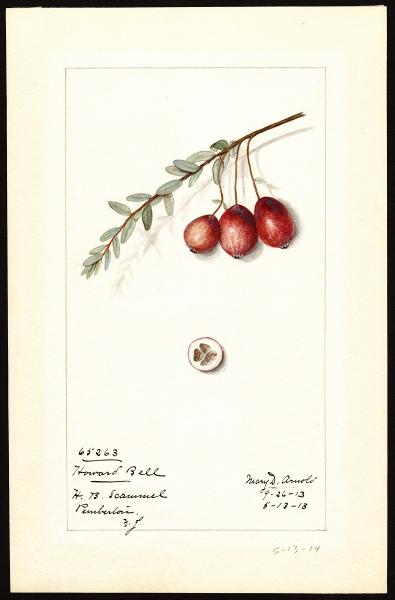
Vaccinium macrocarpon: Howard Bell
Artist: Arnold, Mary Daisy
Date: 1914
Scientific name: Vaccinium macrocarpon
Common name: American cranberry
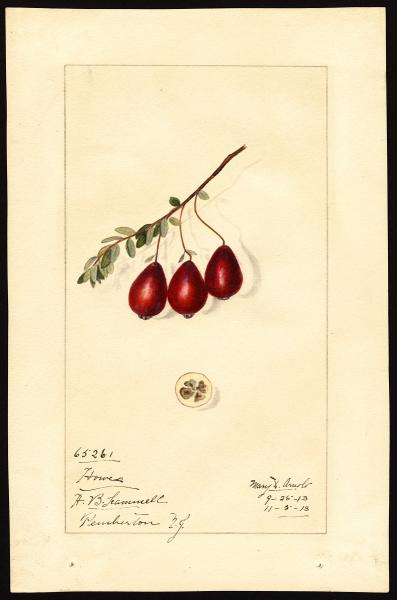
Vaccinium macrocarpon: Howes
Artist: Arnold, Mary Daisy
Date: 1913
Scientific name: Vaccinium macrocarpon
Common name: American cranberry
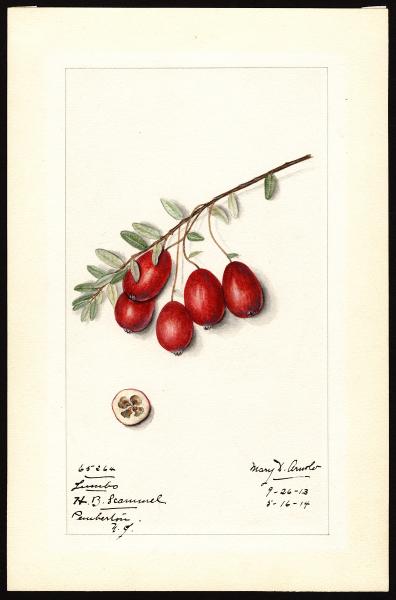
Vaccinium macrocarpon: Jumbo
Artist: Arnold, Mary Daisy
Date: 1914
Scientific name: Vaccinium macrocarpon
Common name: American cranberry
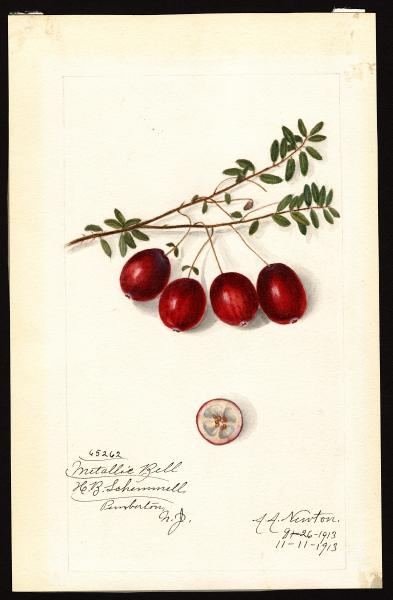
Vaccinium macrocarpon: Metallic Bell
Artist: Newton, Amanda Almira
Date: 1913
Scientific name: Vaccinium macrocarpon
Common name: American cranberry
The U.S. Department of Agriculture published many materials at the start of the twentieth century to help farmers establish, grow, and manage this crop. Here is a sample of these publications.
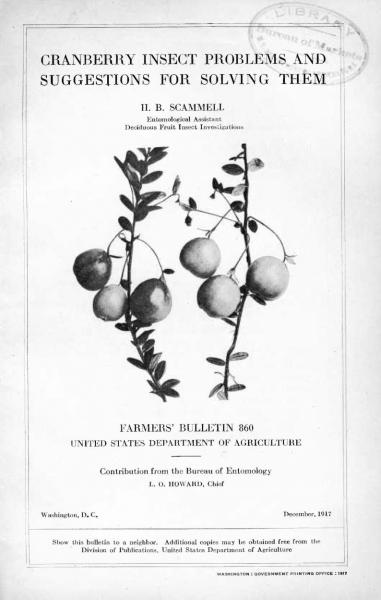
An abundant water supply, permitting flooding and reflooding at the proper times, is the best remedy for insect injury in cranberry bogs, and when the sites of new bogs are to be chosen this should always be borne in mind. On cranberry land where the water supply is insufficient, however, spraying, sanding, and other measures will have to be used.
The cranberry has many insect enemies, but some of them are of importance only on dry bogs. The foliage is attacked by three species of "fireworms," the tipworm, spanworms, army worms, and the cranberry fieabeetle; the fruit is eaten by the fruitworm, blossom worm, cranberry katydid, and grasshoppers; the vine is attacked by the girdler, toadbug, vinehopper, spittle insect, mealybug, and Putnam and oyster-shell scales; and the roots are destroyed by the rootworm and white grubs. This bulletin gives brief descriptions of these pests, their life histories, and the means found most effective, in each case, in preventing their ravages and destroying them.
-- p. 2
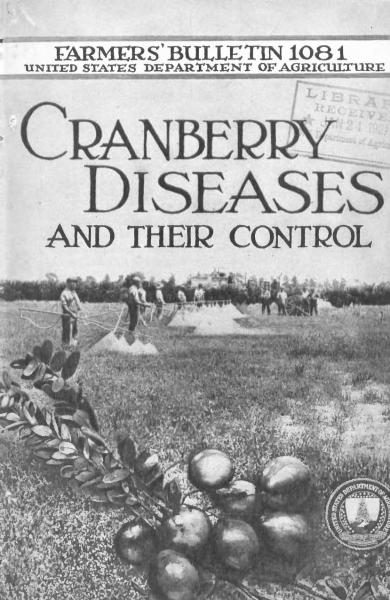
Shear, C.L. (1920) Cranberry Diseases and Their Control. Farmers' Bulletin, Number 1081
The American cranberry has been in cultivation in this country for nearly a century. Some of the present cranberry meadows have been bearing fruit for 50 years or more. This long-continued growth of the same crop on the same land under the same conditions has favored the development and spread of certain diseases, some of which at present are unknown or rarely found on wild cranberries. These diseases are gradually spreading and becoming more serious….
The cranberry plant differs greatly from most cultivated plants in its food and water requirements and also in its method of obtaining certain portions of its food. In common with most of the plants of the heath family, it requires an acid soil and obtains part of its nutriment through the aid of a beneficial fungus, known as mycorhiza, which lives in the rootlets. There is much yet to be learned in regard to the best conditions and methods necessary for the production of the most vigorous and healthy cranberry plants. A plant, like an animal, when lacking proper and sufficient food or water becomes weakened and more susceptible to disease than one that is properly nurtured and hardy.
Every cranberry bog differs from every other, and in many cases different parts of the same bog differ in the origin and composition of the soil and in the character and distribution of the soil water and plant food. Experience, careful observation, and study must determine the most satisfactory methods of handling a particular bog in order to obtain the most vigorous, healthy, and productive vines.
--p. 3-4
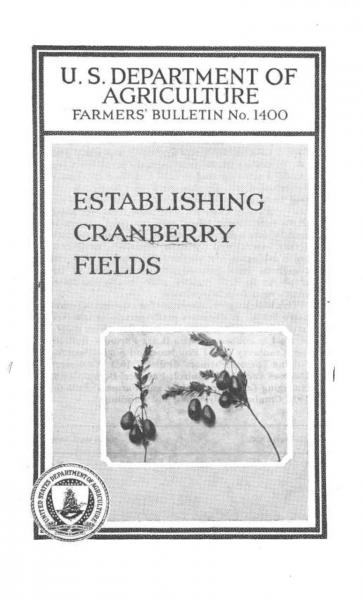
The cranberry was first cultivated about 1820 in eastern Massachusetts, and except for a few hundred acres devoted to it in Canada its culture is almost wholly confined to the United States. In the past hundred years the area planted to this fruit has been gradually extended until now there are about 30,000 acres under vines, with the chief centers in eastern Massachusetts, central and southern New Jersey, central and northern Wisconsin, southwestern Washington, and northwestern Oregon. Natural conditions have favored the development of the cranberry in these regions, where nearly the entire commercial crop is produced.
This bulletin gives directions for establishing cranberry fields. It discusses many principles involved in cranberry growing. Other bulletins which should be read in connection with it are Farmers' Bulletin 860, Cranberry Insect Problems and Suggestions for Solving Them; Farmers' Bulletin 1081, Cranberry Diseases and Their Control; Farmers' Bulletin 1401, Managing Cranberry Fields; and Farmers' Bulletin 1402, Cranberry Harvesting and Handling.
-- p.2
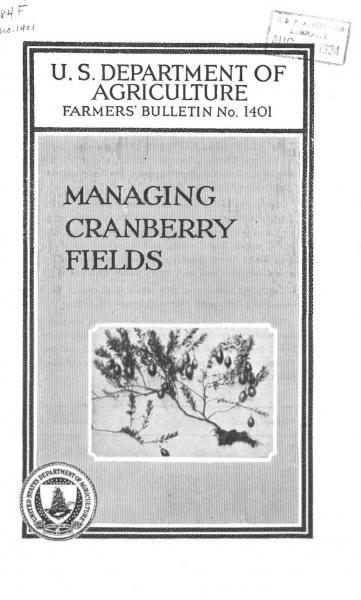
Managing cranberry fields necessitates a knowledge of insect and disease control, flooding for protection against winter injury and frosts, weather forecasting, fertilizers, and weeding. Much of this knowledge can be gained only by experience, for the conditions surrounding cranberry fields are extremely variable. Details regarding each operation will therefore be varied to suit local needs. -- p. 1
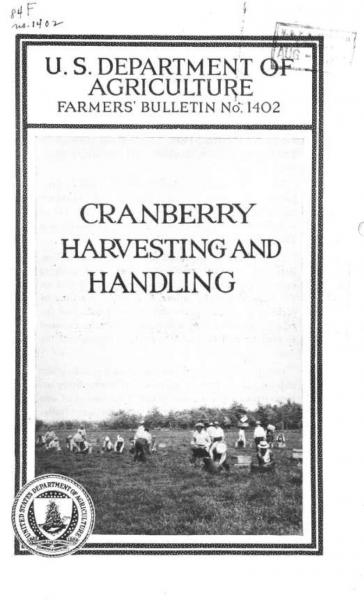
In order to harvest and market a cranberry crop in the best condition it is necessary, first of all, so to construct and manage the field that sound berries are produced. Such fruit, though naturally possessing good keeping qualities, may be spoiled in handling, or it may be so handled that it can be shipped to the most distant market in the United States in good condition. As commonly handled, however, perhaps the loss between field and consumer has been greater with the cranberry than with any other, fruit. Losses to the grower start in the field, where ordinarily 5 to 15 per cent and sometimes even 30 per cent of the crop is left by the pickers. A second loss occurs from natural shrinkage of the berries, due mostly to respiration. This shrinkage is slight when the berries are shipped immediately after picking and consumed within a short time, but when the crop is held in storage for some months it may reach 12 per cent. A third loss occurs when, as the result of injury in picking or in handling the boxes of berries, in "screening," and in packing, fungi infect the berries and they decay. Still other losses may occur as the result of freezing and smothering. Recent investigations have revealed the causes of most of the losses, and the experience of certain growers has shown that many of them can be avoided. The organization of growers into both educational and cooperative selling associations has furnished a means of informing them concerning such losses and the practical means of controlling them. The results of experiments and the experience of growers are presented in the following pages. -- p. 1-2
 An official website of the United States government.
An official website of the United States government.